Can you freeze green beans? Yes, you can…and they taste amazing! Learn how to freeze green beans in no time with this easy step by step tutorial!
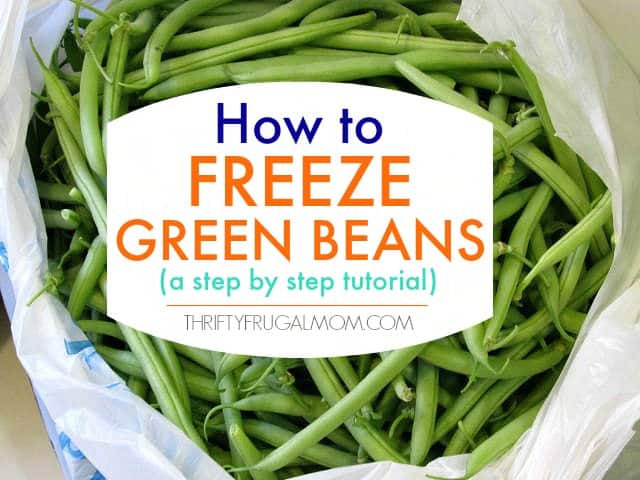
One of the ways that I save quite a bit of money on groceries is by preserving lots of fruits and vegetables.
While we live in the city and don’t have room for a big garden, we’re blessed to live in an area where we can get lots of beautiful, homegrown produce for great prices. So I simply buy large amounts from local growers and then preserve them for us to enjoy all year long.
I know that canning and freezing produce sounds really daunting to many people, so I’ve done a number of step by step canning and freezing tutorials to show you just how simple the process really is.
Today I’m going to show you how to freeze green beans. Not only are they super easy to preserve by freezing, they also taste so much better than store-bought!
In fact, recently I saw a great deal on some frozen beans at the store and decided to buy a couple of bags thinking it would help stretch our supply since I hadn’t frozen as many this year as I probably should have.
I made them for dinner and after one bite my husband commented, “It’s no wonder so many people don’t like vegetables!”
And I had to agree. They just were nowhere near as tasty as the green beans that I freeze!
The benefits of freezing green beans vs. canning them
There are affiliate links in this post. As an Amazon Associate, I earn from qualifying purchases. Please read my full disclosure policy.
You can preserve your beans by canning or freezing them. If you choose to can them, you need to use a pressure canner since using a regular canner doesn’t reach high enough temps to kill the bacteria that causes botulism.
I find the pressure canning process rather time-consuming and tedious plus it also makes the beans less nutritious. Did you know that frozen veggies and fruit have almost as much nutritional value as when they are fresh?
So, I prefer to simply freeze our green beans. And once you see how amazingly easy it is to do, I think you’ll understand why!
Supplies for freezing green beans
- Dishpan or container to put the beans in
- Paring Knife (love this one!)
– You can also use your fingers to do this, but I find it harder and it doesn’t look as nice either. - Blancher
– You can use a big pot instead but it gets a bit complicated when it comes time to drain the beans and cool them quickly
(Don’t have a blancher and don’t want to buy one? See if you can find a friend that has one that you could borrow.) - Freezer bags or freezer-safe containers to store the beans
– I like using these freezer boxes.
How to Freeze Green Beans
1. Trim the bean ends
Remove the ends of the beans and any defective spots. If you have true “string” beans, remove the strings too.
Technically you don’t have to remove the tail end of the bean, just the end that was attached to the stalk. However, I don’t like the look of leaving them on so I remove them too.
2. Cut the beans into smaller pieces
Break or cut the beans into 1 to 1 ½ inch pieces.
If you have children, this is a step that even little children can help with. In fact, they often think it is fun!
3. Wash the beans.
Wash the beans thoroughly in cold water. I like to put a dishpan full of beans in my sink and then just fill it with water.
Swish the beans around really well to work any dirt loose.
4. Fill the blancher’s colander
Move the beans over to the colander insert of your blancher, filling it to just below the ridge.
You want the beans to not go above the top row of holes so that they will be covered with water during the blanching process.
5. Fill the blancher with water
Fill the kettle part of the blancher about 2/3 to 3/4 full of water. You don’t want it too full because the water level will rise once you put the colander full of beans into it.
Bring the water to a full, rolling boil.
6. Insert the colander into the boiling water
Slowly (this is important so that the water doesn’t go splashing out!) insert the colander full of beans into the boiling water. Once you put the beans in, the water will stop boiling.
7. Bring the pot to a rolling boil
Watch the pot carefully and once the water comes to a rolling boil again, remove the beans immediately. You just want to slightly cook the beans.
(In the picture above I wasn’t watching the pot closely enough and it had been boiling for a bit when I noticed it. You don’t want that much of a boil! It isn’t tragic, but the beans just won’t taste quite as good.)
8. Cool the beans
While you are waiting for the beans to boil, fill a dishpan or sink with cold water- the colder the better.
Once you remove the beans from the boiling water, immerse the colander in the cold water, making sure that all the beans are submerged.
Cool the beans down as fast as possible. It helps to swish the colander around in the water, keep the water running, use your hands to move the beans around and even change the water if necessary.
9. Drain the beans
Once the beans are nice and cool, drain the water off of them.
10. Transfer beans to freezer-safe containers
Put the blanched beans in freezer bags or freezer-safe containers and freeze immediately.
I typically use these freezer boxes to freeze our food just because I like the way they store and it’s also cheaper in the long run since you can use them over and over again.
And that’s all there is to freezing green beans! So easy, but it produces such tasty beans.
Also, while we’re on the subject of green beans, I highly recommend this amazing Cheesy Ham, Potato and Green Bean Casserole. It’s made totally from scratch and is total comfort food!
How to Freeze Fresh Green Beans
Equipment
- Dishpans or containers to put the beans in
- Paring Knife
- Blancher
- Freezer bags or freezer safe containers to freeze the beans in
Ingredients
- Green Beans
Instructions
- Remove the ends of the beans and any defective spots. If you have true “string” beans, remove the strings too. Technically you don’t have to remove the tail end of the bean, just the end that was attached to the stalk. However, I don’t like the look of leaving them on so I remove them too.
- Break or cut the beans into 1 to 1 ½ inch pieces.
- Wash the beans thoroughly in cold water. I like to put a dishpan full of beans in my sink and then just fill it with water. Swish the beans around really good to work any dirt loose.
- Move the beans over to the colander insert of your blancher, filling it to just below the ridge. Basically you want the beans to not go above the top row of holes so that they will be covered with water during the blanching process.
- Fill the kettle part of the blancher about 2/3 to 3/4 full of water. You don’t want it too full because the water level will rise once you put the colander full of beans into it. Bring the water to a full, rolling boil.
- Slowly (this is important so that the water doesn’t go splashing out!) insert the colander full of beans into the boiling water. Once you put the beans in, the water will stop boiling.
- Watch the pot carefully and once the water comes to a rolling boil again, remove the beans immediately. You basically just want to slightly cook the beans.
- While you are waiting for the beans to boil, fill a dishpan or sink with cold water- the colder the better. Once you remove the beans from the boiling water, immerse the colander into the cold water, making sure that all the beans are submerged. Cool the beans down as fast as possible. It helps to swish the colander around in the water, keep the water running, use your hands to move the beans around and even change the water if necessary.
- Once beans are nice and cool, drain the water off of them.
- Put the blanched beans in freezer bags or freezer-safe containers and freeze immediately.
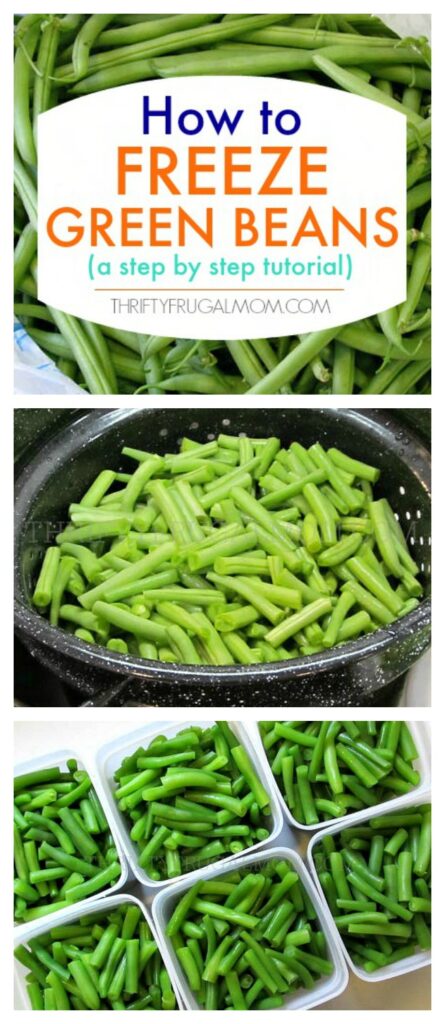

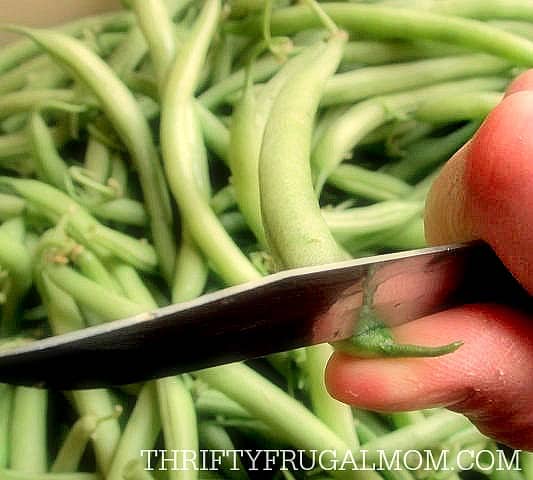
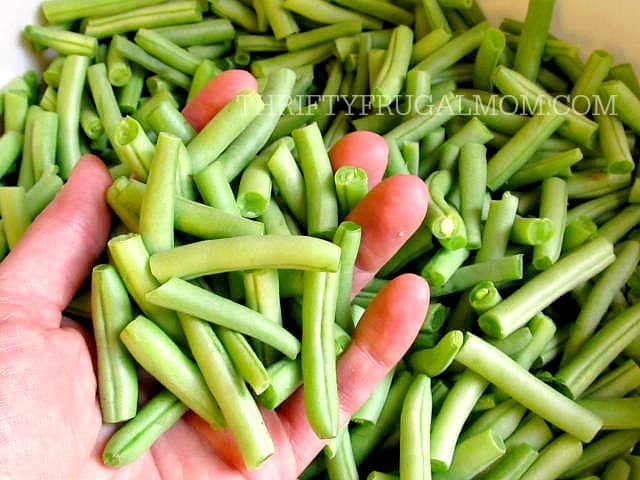
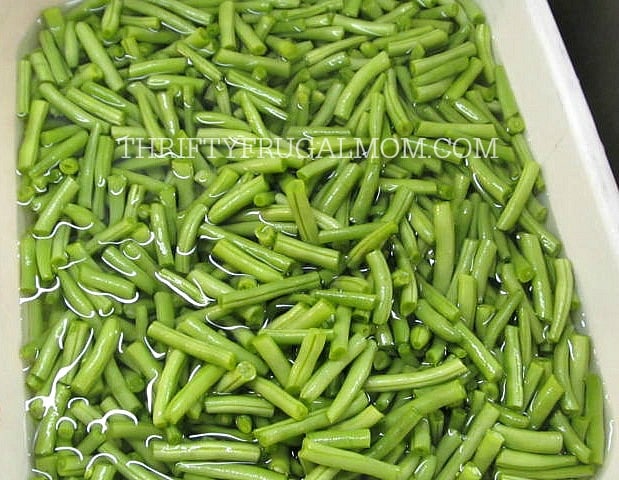
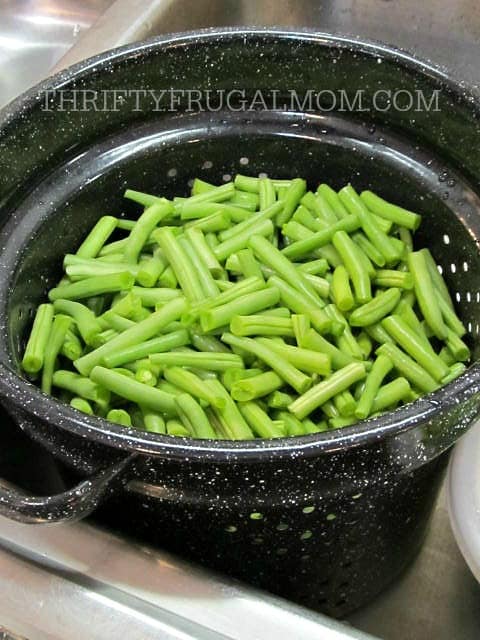
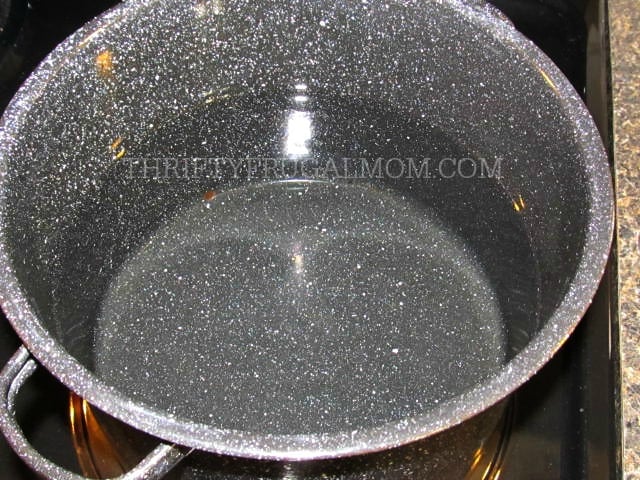
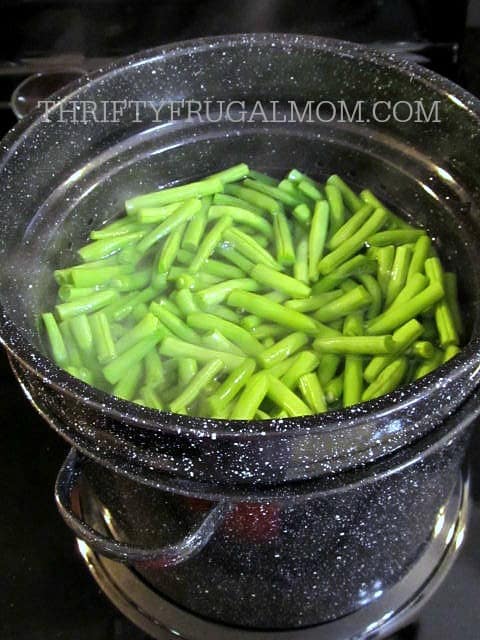
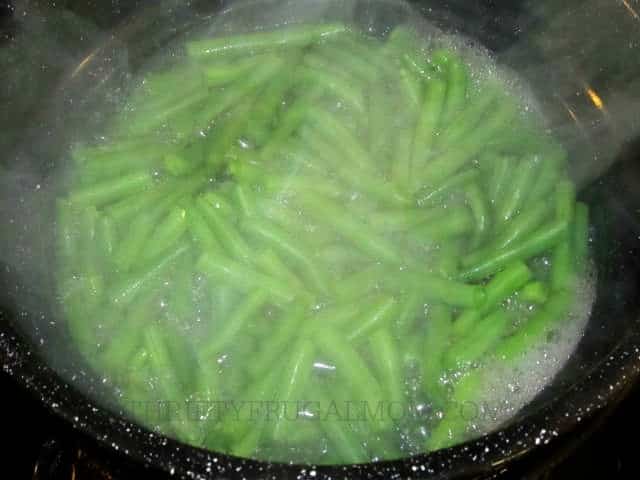
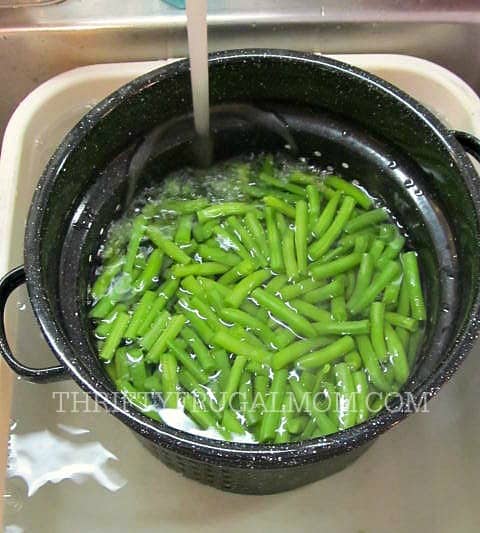
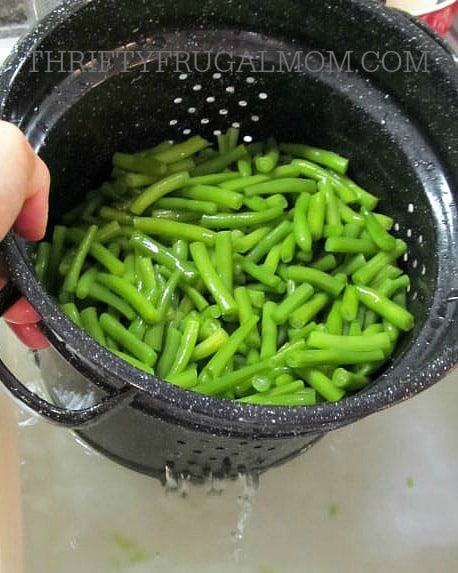
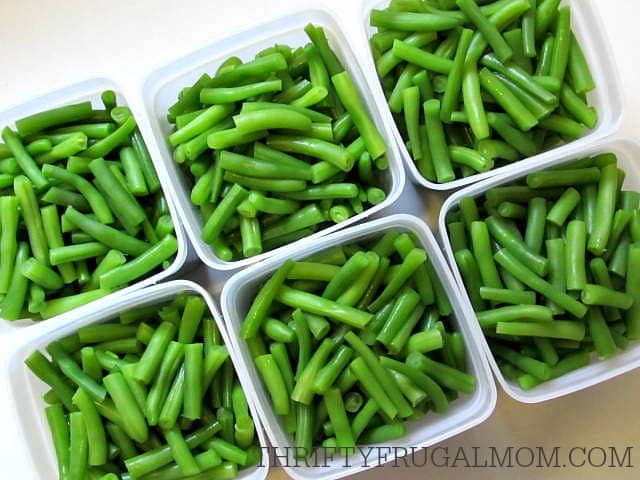
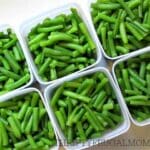

Mary C
I’m having trouble with my beans tasting “pithy” for lack of a better description after I pressure cook them with potatoes and ham. I only pressure cook for the 4 to 5 minutes like my book says. So if I blanched the beans first, would I then be able to put them in the pressure cooker with the ham and potatoes and cook for 4 to 5 minutes without the beans tasting pithy? Or would a crock pot be a better way to cook the beans, potatoes and ham?
Thanks for your help on this.
mary c
ThriftyFrugalMom
Mary, by pithy do you mean soft? Or are you meaning more chewy and tough? If it’s just that they are soft, it’s probably because they are being over cooked. When I pressure my fresh green beans, I only do them 3 minutes. If they were blanched and then frozen, I only do them 2 minutes. And even then, they are pretty soft, which is the way we like them. Obviously if you are pressuring them with the ham and potatoes though you are going to need to do them longer to get the potatoes cooked. I really don’t know how long you need to do them, since I always go by whatever my book says too for that kind of thing. I would guess a crockpot would be the best simply because it would cook it low and slow and that usually creates a really good flavor! Not sure if that was any help, but it’s the best I know! 🙂
Lisa Alexander
Thanks for the tutorial! The green beans I planted didn’t survive but the okra did and it’s coming in in great abundance! I’ve been rinsing and putting in the freezer till I can get enough to make my okra-tomatoes-shrimp-sausage dish. Any ideas on freezing okra? Many thanks!
ThriftyFrugalMom
Lisa, sorry for the slow response! I thought I had replied to your comment, but apparently got interrupted (yay for having little kids!) and never actually got it done!
What a bummer that your green beans bit the dust (literally!). 🙂 Gardening can be tough.
But yay for the okra! I’ve never planted that or tried to preserve it, but I looked in my trusty Mennonite Country-Style Recipes cookbook that has a ton of helpful canning info and it says this:
Not sure if you are familiar with blanching or not, but the process of boiling produce for just a tiny bit like that helps stop the enzymes from breaking down and will preserve flavor and taste.
Hope that helps! 🙂
Karren
Lisa, I freeze mine whole (with the ends still attached) after washing, then when I’m ready to use them, I cut off the ends & cut into pieces. You need to cut them while they are still mostly frozen because if you wait till they thaw they will be limp. We dredge okra in cornmeal & fry it immediately & it tastes just like we just picked it out of the garden. We have done okra this way for about 30 years.
Kelsey Ferguson
This brought back lots of great memories of my grandma canning beans. I’m not sure she ever froze them, though! What a great, frugal idea. Pinning it to come back to later.
ThriftyFrugalMom
Kelsey, I think years ago most people canned them simply because freezer space was harder to come by. I like canned green beans too, but in order to do them safely you have to use a pressure cooker, and I don’t own one. So freezing is just easier!
Michele Morin
My favorite thing about the whole post?
The pictures! Love seeing all that green because it mirrors my kitchen right now!
I have always canned my beans, but aren’t beans just a lovely and bountiful gift from God?
ThriftyFrugalMom
So you’re in the thick of green bean preserving, I take it? 🙂 Yes, I love green beans and they typically produce so nicely! I like canned green beans too, but since I don’t have a pressure cooker to safely can them, I have to stick with freezing them. My hubby prefers the taste of the frozen ones too, so I guess that’s an added bonus!
Brenda Anderson
How long do the beens need to be cooked when they are being prepared to eat?
ThriftyFrugalMom
Brenda, I depends on how soft or crunchy you like them! I typically use a pressure cooker to cook ours and I pressure them for 2 to 3 minutes. When I cook them in a regular kettle, I just periodically check them until they are cooked as soft as we like them. Sorry I don’t have a more exact answer for you!
Alice
Love the idea of freezing. We planted beans for the first time in our garden. Could you season right away or do you recommend that they be frozen plain.
Thanks
ThriftyFrugalMom
Fun! Hope your beans do really well for you. I always think they are kind of fun to pick. I wouldn’t know why you couldn’t season them frozen, although, I wouldn’t do it until you go to put them in the freezer bags. (In other words, don’t season them during the blanching process. I don’t know if it would hurt or not, but I’d hate for you to try it.) The only downside to seasoning before you freeze them is that when you go to cook them before eating, you might lose some of the seasoning in the water.